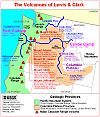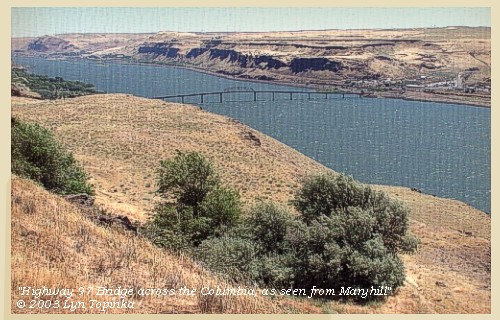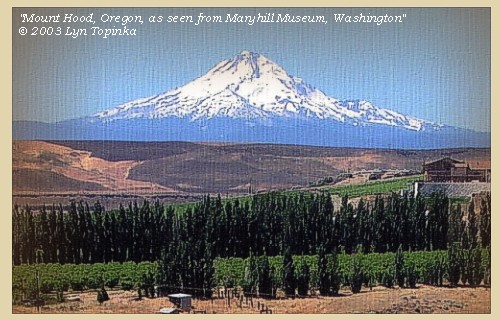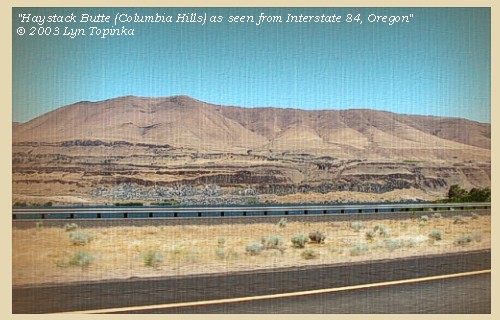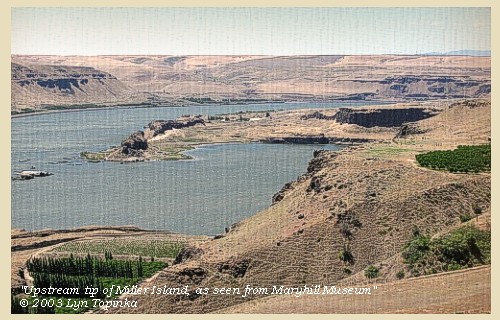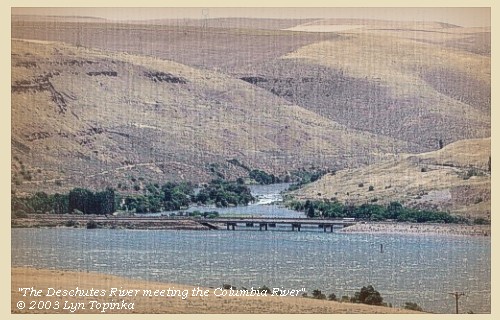Lewis and Clark
|
October 22, 1805 "Great Falls of the Columbia" - Maryhill to Celilo |
|
Home
The Volcanoes of Lewis and Clark Map of the Journey Volcanoes, Basalt Plateaus, Major Rivers, etc. The Volcanoes Mount Adams, Mount Hood, Mount Jefferson, Mount Rainier, and Mount St. Helens CALENDAR of the Journey October 1805 to June 1806 Along the Journey Pacific Northwest Maps - Columbia River, Volcanoes, Flood Basalts, Missoula Floods, Geology, etc. The Corps of Discovery The Journey of Lewis and Clark About the Reference Materials The Journals, Biddle/Allen, DeVoto, Gass, Moulton, Topo Maps, and others USGS Lewis and Clark Links Links to USGS Websites highlighting the Lewis and Clark Journey Resources Publications Referenced and Websites Visited |
PREVIOUS
October 21 Rapids and Rivers, Roosevelt and Arlington to the John Day |
October 22
"Great Falls of the Columbia" Maryhill to Celilo Five-Mile Rapids, U.S. Highway 97 Bridge, and Maryhill (Washington), Maryhill State Park, Mount Hood, Haystack Butte and the Columbia Hills, Miller Island, Deschutes River, Deschutes River State Recreation Area, "Great Falls of the Columbia", Celilo Falls and, Wishram (Washington), Celilo Locks and Canal |
CONTINUE
October 23 "Great Falls of the Columbia" |
|
To the Pacific - October 1805
"Great Falls of the Columbia" - Maryhill to Celilo |
| Lewis and Clark's camp of October 21, 1805, was on the Washington side of the Columbia, downstream of the site of modern John Day Dam, and upstream of the Maryhill area. On October 22, 1805, Lewis and Clark left the John Day area headed for the "Great Falls of the Columbia". |
| Tuesday, October 22, 1805 |
| The morning was fair and calm. We left our camp at nine o'clock, and after going on for six miles came to the head of an island, and a very bad rapid [an 1858 map refers to as "Five Mile Rapids", today the site of the "Biggs Bridge"], where the rocks are scattered nearly across the river. Just above this and on the right side are six huts of Indians [Maryhill vicinity]. |
| A fantastic view of Mount Hood can be seen from the hill at Maryhill Museum. The Corps noted the peak on their return trip in 1806, as they road horseback along the ridge -- see entry of April 22, 1806. |
| At the distance of two miles below, are five more huts; the inhabitants of which are all engaged in drying fish, and some of them in their canoes killing fish with gigs; [below Haystack Butte, Columbia Hills, Washington] |
| opposite to this establishment is a small island in a bend towards the right, on which there were such quantities of fish that we counted twenty stacks of dried and pounded salmon. This small island is at the upper point of one much larger [Miller Island] , the sides of which are high uneven rocks, jutting over the water: here there is a bad rapid [Deschutes Rapids]. |
| The island [Miller Island] continues for four miles, and at the middle of it is a large river [Deschutes River], which appears to come from the southeast, and empties itself on the left. We landed just above its mouth in order to examine it, and soon found the route intercepted by a deep, narrow channel, running into the Columbia above the large entrance, so as to form a dry and rich island about 400 yards wide and eight hundred long. ...... |
| "... this River haveing no Indian name that we could find out, except "the River on which the Snake Indians live", we think it best to leave the nameing of it untill our return. ..." [Clark, October 22, 1805] |
|
We reached the river about a
quarter of a mile above its mouth, at a place where a
large body of water is compressed within a channel
of about two hundred yards in
width, where it
foams over rocks, many of which are
above the surface of the water.
These narrows are
the end of a rapid
[an 1858 map calls this "Five Mile Rapids"]
which extends two miles back, where the river is closely
confined between two high hills, below which it is
divided by numbers of large rocks and small
islands, covered with a low growth of timber.
This river, which is called by the
Indians Towahnahiooks
[Deschutes River],
is two hundred yards wide at its
mouth, has a very rapid current, and contributes
about one fourth as much water
as the Columbia possesses before the junction.
Immediately at the entrance are three sand islands,
and near it the head of an island
[???]
which runs parallel
to the large rocky island
[Miller Island].
We now returned to our boats, and passing the mouth of the Towahnahiooks [Deschutes River] went between the islands. At the distance of two miles we reached the lower end of this rocky island [Miller Island], where were eight huts of Indians. Here too, we saw some large logs of wood, which were most probably rafted down the Towahnahiooks [Deschutes River]; and a mile below, on the right bank, were sixteen lodges of Indians, with whom we stopped to smoke. |
| "Great Falls of the Columbia" |
|
Tuesday, October 22, 1805 - Continued |
| Then at the distance of about a mile passed six more huts on the same side, nearly opposite the lower extremity of the island [???], which has its upper end in the mouth of the Towahnahiooks [Deschutes River]. Two miles below we came to seventeen huts on the right side of the river, situated at the commencement of the pitch [Wishram, Washington, vicinity] which includes the great falls [Celilo Falls]. |
| "... 6 miles below the upper mouth of 'Towornehiooks' River the commencement of the pitch of the great falls, opposit on the Stard. Side is 17 Lodges of the nativs we landed and walked down accompanied by an old man to view the falls, and the best rout for to make a portage which we Soon discovered was much nearest on the Stard. Side, and the distance 1200 yards one third of the way on a rock, about 200 yards over a loose Sand collected in a hollar blown by the winds from the bottoms below which was disagreeable to pass, as it was steep and loose. ..." [Clark, October 22, 1805] |
|
|
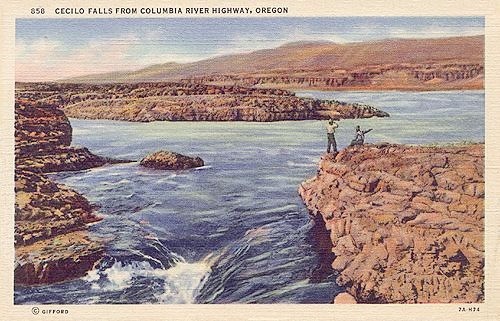
Celilo Falls ("Great Falls of the Columbia"): Celilo Falls was known as the "Great Falls of the Columbia". The Columbia River cut into basalt rock to create a constriction of the river with a twenty-foot falls followed by a mile of narrow, channeled rapids with a drop of eight feet in river elevation. The Lewis and Clark expedition arrived at the "Great Falls of the Columbia" in late October, 1805, and were forced to portage around to continue on downriver. In the spring of 1806 they had to pass through the falls again on their journey home. The Celilo Falls were drowned in 1957 with the construction of The Dalles Dam. -- Washington State University Library Collections Website, 2002, Washington State Historical Society Website, 2002 












|
| Here we halted, and immediately on landing walked down, accompanied by an old Indian from the huts, in order to examine the falls, and ascertain on which side we could make a portage most easily. We soon discovered that the nearest route was on the right side [Washington side, Wishram area], and therefore dropped down to the head of the rapid, unloaded the canoes and took all the baggage over by land to the foot of the rapid. The distance is twelve hundred yards. |
| Mount Hood, Oregon is visible along this stretch of the Columbia River. |
|
|
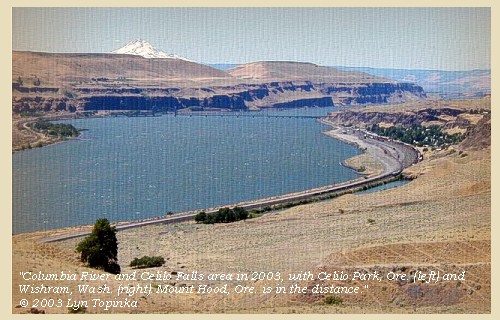
Celilo Falls area and Wishram today: Today the Celilo Falls area has been inundated with the waters of Lake Celilo, the reservoir behind The Dalles Dam. Across from Wishram, Washington, is now Celilo Park, Oregon. 



|
| On setting out we crossed a solid rock, about one third of the whole distance; then reached a space of two hundred yards wide, which forms a hollow, where the loose sand from the low grounds has been driven by the winds, and is steep and loose, and therefore disagreeable to pass; the rest of the route is over firm and solid ground. The labour of crossing would have been very inconvenient, if the Indians had not assisted us in carrying some of the heavy articles on their horses; but for this service they repaid themselves so adroitly, that on reaching the foot of the rapids we formed a camp in a position which might secure us from the pilfering of the natives, which we apprehend much more than we do their hostilities. ...... |
| "... the waters is divided into Several narrow chanels which pass through a hard black rock forming Islands of rocks at this Stage of the water ..." [Clark, October 22, 1805] |
| In 1905, one-hundred years after Lewis and Clark's passage through this area, the Celilo Canal and Locks were built. |
|
|
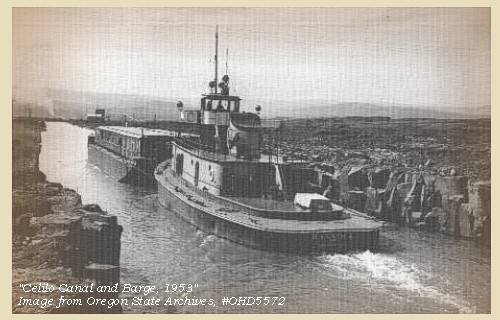
Celilo Locks and Canal: Prior to 1863, boats operating on the upper river above Celilo and those coming upriver to The Dalles were linked by a wagon-road portage in order to avoid the treacherous rapids. In 1863, the Oregon Steam Navigation Company completed a 13-mile iron-railed portage line along what had been known as Thompson's Portage, between The Dalles and Celilo on the Oregon shore. The Dalles - Celilo railroad and connecting river steamers operated regularly for a number of years. In October 1905, the U.S. Army Corps of Engineers began work on The Dalles - Celilo Canal, one of the most significant early projects of the Corps' Portland District. The 8 1/2-mile-long canal consisted of five locks, each with an eight-foot lift. The Corps completed and officially opened the canal on May 5, 1915. This canal provided passage around Celilo Falls and the Long Narrows until The Dalles Dam replaced it in 1957. The filling of the reservoir behind The Dalles Dam in March 1957 inundated the canal, ending its 40-year history. Traffic now pass through the navigation lock on the Washington shore of the Project. -- U.S. Army Corps of Engineers Website, 2002, and Center for Columbia River History Website, 2002 


|
| Besides fish, these people supplied us with filberts and berries, and we purchased a dog for supper; but it was with much difficulty that we were able to buy wood enough to cook it. In the course of the day we were visited by many Indians, from whom we learnt that the principal chiefs of the bands, residing in this neighbourhood, are now hunting in the mountains towards the southwest. [Cascade Range] On that side of the river [Oregon side] none of the Indians have any permanent habitations, and on inquiry we were confirmed in our belief that it was for fear of attacks from the Snake Indians with whom they are at war. This nation they represent as very numerous, and residing in a great number of villages on the Towahnahiooks [Deschutes River], where they live principally on salmon. That river [Deschutes River] they add is not obstructed by rapids above its mouth, but there becomes large and reaches to a considerable distance: the first villages of the Snake Indians on that river being twelve days' journey on a course about southeast from this place. |
|
|
|
The Camp - October 22 and 23, 1805:
Lewis and Clark's camp of October 22 and 23, 1805, was on the Washington side of the Columbia River, downstream of Wishram, Washington, and across from Oregon's Celilo Park. 
|
| Home | Previous | Continue |
If you have questions or comments please contact: GS-CVO-WEB@usgs.gov
June/July 2004, Lyn Topinka
The Volcanoes of Lewis and Clark Home Page | CVO Home Page

